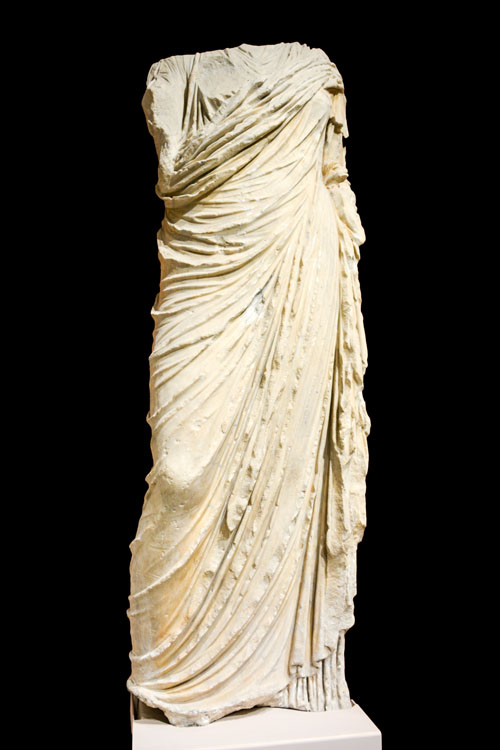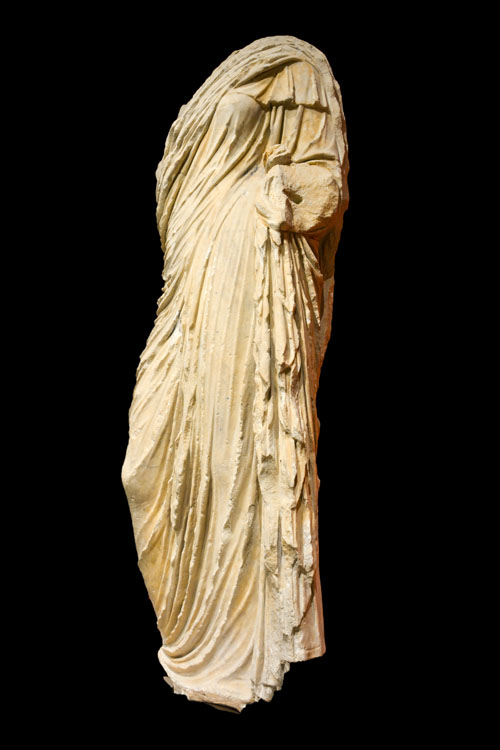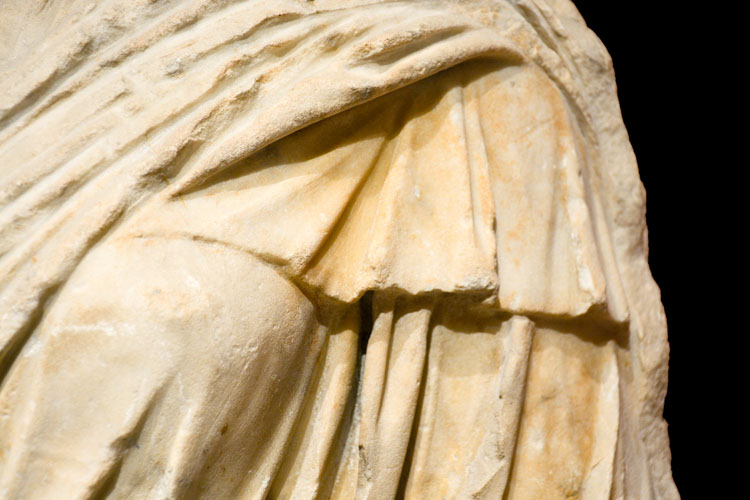Draped female figure: Julia Augusta (Livia)
Category
Gozo GroupAbout This Artefact
I.D. no: 100898
Dimensions: Max. H. 148 cm; Max. W. 48 cm
Material: Fine grain white marble with barely perceptible grey streaks.
Provenance: Unknown provenance, but certainly from Gozo.[1]
Current location: Gozo Museum of Archaeology.
Condition: Apart from the missing head, which must have been worked separately and fitted in a hollow carved for the purpose,[2] the upper part of the statue is affected by two large breaks: one depriving the statue of the top of its right shoulder, and one over the right breast. Both the right and the left forearms are broken off, but holes for dowels suggest that both were attached separately. Large breaks also affect the thick cluster of folds hanging from the left arm and the crests of most of the folds of the drapery.
Also missing are the feet and that part of the statue below the lower edge of the mantle that must have once been inserted inside the purposely hollowed-out upper surface of the supporting marble base carrying an inscription dedicated to Ceres Julia Augusta preserved in the same museum. The statue must have had a flat bottom surface and two protruding pegs which fitted into the irregular contour of the said hollow and two circular holes at its bottom.[3]
A honey-coloured patina covers the whole surface that is unaffected by the breaks and chips; a few traces of black survive inside the folds near the left elbow
Description: The standing figure is supported by the left leg, the right leg being flexed at the knee in the act of moving forward. The left arm, bent at the elbow, must have extended its forearm forward. The figure wears a sleeved chiton that is buttoned up on the shoulders and upper arms (visible only on the right one, and at the very bottom, near the left foot) and, over it, the heavier woollen himation, or mantle. The latter covers diagonally the back from the left shoulder to the right hip to pass under the right arm from where it climbs back diagonally with a thickened swag of folds over the left shoulder, sparing the right breast. From the left shoulder hangs an unusual short overlap. The two long edges of the mantle are held together on the inner side of the left arm whence they hang vertically in a zigzagging pattern down the side.
Discussion: The statue repeats a type of draped female statue which was probably created in the fourth century BC and which is commonly known as the “Kore of Praxiteles” or the “Kore of the Vatican”.[4] Our statue corresponds to Hekler’s type XX,[5] and would fall under subsection (a) of the two subsections of the type recognized by Alföldi-Rosenbaum.[6] As opposed to the statues of subsection (b) those of (a) (including the Gozo statue) have a long mantle which falls very low, covering the chiton almost completely, and the group of folds crossing the chest diagonally retains the same width and thickness without unfurling over the left shoulder. The Gozo statue is almost identical to the several replicas from Cyrene,[7] and from Barcelona,[8] with which it shares the abundance of crimpled, sharp-crested folds that contribute to emphasize the vigorous structure of the body underneath. Other statues of the same type, datable to the Julio-Claudian years, but classifiable under subsection (b), are one from Veleia (Livia), now in Parma,[9] another from Olympia (Agrippina the Younger),[10] as well as two others from Sicily.[11]
The closest parallel in almost all aspects of posture (including the position of the arms and drapery) is, however, the draped female statue in the National Museum of Antiquities in Leiden,[12] even if it is less fussy in the multiplicity of curvilinear folds from the waist down, and lacks the sleeve-like edge of the mantle over the left upper arm of the Gozo statue. Both statues have been classified by Filges under his “Kore/Persephone-Typus Berlin Leiden” together with similar statues in Krakow, Termini Imerese and Parma Inv. No 831.[13] More recently Alexandridis, in her Appendix I, placed it under group 1.2 denominated as “Ausgeschlossen oder nicht zu ermittelnde Bildnisse” and, in her Appendix II under group 2.2.24 (Schulterbausch-Typen) and as a variant 3 of sub-type A (Typus Berlin/London und Typus Ancona/Rom).[14]
Although headless, there does not seem to be any doubt any longer that the Gozo statue represents Livia, wife of Augustus.[15] The inscription carved on the face of the marble base on which it was originally intended to stand refers to her as Iulia Augusta represented as Ceres to whom a monument (presumably the statue itself) was dedicated by Lutatia, daughter of Marcus Optatus.[16] In this respect it is very likely that she carried ears of grain in one of her hands, rather than a cornucopia, like the well-preserved version in the Louvre.
Date: Generally to the reign of Tiberius (AD 14-37) on account of the inscription. Although the inscription refers to her specifically as mother of Tiberius and the title of Augusta mentioned in it was conferred upon Livia by him immediately after the death of Augustus, her consecration as Diva Augusta in the early years of Claudius’ reign, precisely in AD 41 or 42, suggests the possibility of a date in the reign of Claudius.
Bibliography: (previous publications of item): Abela 1647: 216-17 (Cestius Gallus). Lupi 1753: tom. 2, lett. 11 (‘secolo di Tiberio’). Lupi 1753: tom. 2, lett. 11. Houël 1787: 77, pl. 248 (‘figure antique’). Caruana 1881: 7, note 22. Caruana 1882: 113 (‘Ceres Julia Augusta’). Ashby 1915: 27, 70 note 2, fig. 26. CIL X 7501. Reinach 1924: 391, no. 1. Bartels 1963: 55, note 446. Bonanno 1971: 183-87. Bonanno 1992: 40, pl. 33. Winkes 1988: 560-61. Winkes 1995:195-96, no. 124 (Livia). Filges 1997: 245, no 19 (wrongly located in the ‘Valletta Museum’). Bartman 1998: 42-43, 155, Cat. No. 20, fig. 40 (Livia), inscription on pp. 206-07 (Tiberian). Alexandridis 2004: 267.
[1] Already seen and illustrated by Abela (1647: 216-18) and later by Houël (1787: 77, pl. 248) inserted in a rock-cut niche by the side of the old gate to the Gozo Citadel. When in Gozo, Houël (1787: 77) was shown a much damaged, marble female head, with a crown of laurel leaves, apparently of the right size to fit with the statue. Besides, the inscription on its separate statue base describes the husband of Lutatia, the dedicator of the statue, as ‘flamen Gaul[itanorum]’ (CIL X 7501).
[2] The hollow for the insertion of a separately carved head is strikingly shallow (see top plate in Winkes 1995: 196), suggesting that this figure was fitted with a veiled head, an iconography that would have suited the title of Augusta.
[3] See middle and bottom plates in Winkes 1995: 196.
[4] For the various theories relating to the origins of the type see Traversari 1960: 59, and Alföldi-Rosenbaum 1960: 92 who does not accept the connection with the Kore of Praxiteles.
[5] Hekler 1909: 228.
[6] Alföldi-Rosenbaum 1960: 92.
[7] Traversari 1960: 56-61, nos 19-23, pls 11-12 (Julio-Claudian); Alföldi-Rosenbaum 1960: 92-93, nos 155-58, pl. 72.
[8] García y Bellido 1949: 201, no. 241, pl. 168. This partly mutilated statue of the finest quality can be appreciated in 3D on the website of the Museum of Barcelona: http://www.macbarcelona.cat/Col-leccions/La-col-leccio-en-3D/La-col.leccio-del-MAC-en-3D/Roma-en-3D/Estatua-romana-femenina (accessed 12/08/2018). In many ways this and the Gozo statue complement each other, both iconographically and stylistically; for example, the Barcellona preserves the feet and the plinth on which they rest that are missing in the Gozo specimen. It is also dated to the Julio-Claudia dynasty (AD 14-68) and considered to have formed part of a cycle of statues, dedicated to the imperial cult, that adorned the forum of the Roman colonia of Barcino, modern Barcelona.
[9] Saletti 1968: 23-26, no. 1, pls 1-2.
[10] Kron 1977: 149-50, fig. 11 and n. 27. This Olympia statue shares with our statue the edge of an overfold of the mantle on the left shoulder making it obvious that, in both cases, it is part of the mantle and not an additional stola beneath it.
[11] Bonacasa 1964: 58, no. 70, pl. 89 (Agrippina the Elder), and 152, no. 215, pl. 89.
[12] Bastet and Brunsting 1982: 37, no. 72, pl. 21.
[13] Filges 1997: 262, Cat. no. 93, fig. 93 (from Utica, Julio-Claudian)
[14] Alexandridis 2004: 210, 267.
[15] Winkes 1995: 195-96; Bartman 1998: 42-43, 155, 206-07. On Livia see Perkounig1995.
[16] CIL X 7501. It should be noted that the inscribed base on which the statue stood for centuries, inside a rock-cut niche just outside the entrance to the Gozo Citadel, as seen and documented by Abela and Houël (see note 1) was the one dedicated to Cestius Gallus, namely, CIL X 7506; hence the erroneous identification of the figure with that person.




